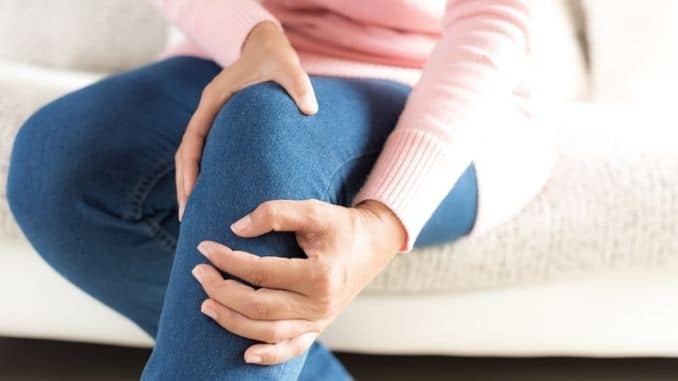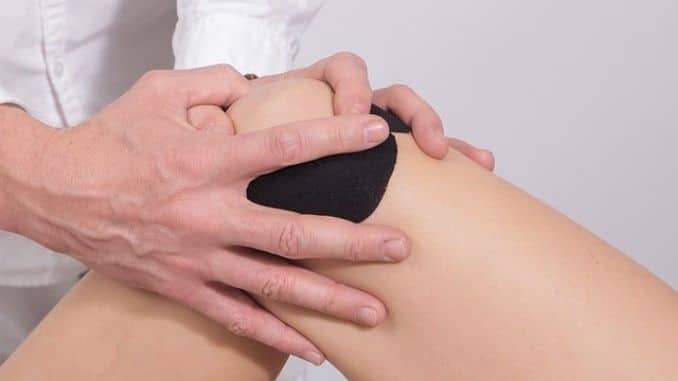
“When I wake up in the morning,” says Leah, who’s going through perimenopause, “I’m stiff as a board. Anyone else suffering from joint pain?”
“I’ve gone through menopause, and I have pain in my legs when walking,” says Glenda. “I’ve also had some swelling in my finger joints.”
“For me, it started in my elbows first,” said Paula. “Right about when I started having hot flashes. Then, it moved to my shoulders. I thought I was the only one!”
Many women have similar experiences, along with other side effects of menopause like hot flashes or mood swings, they may experience joint pain. Is this normal? If so, why?
What Are Menopause and Perimenopause?
Menopause is that stage in life when a woman’s menstrual periods stop. A normal part of aging, it marks the end of the reproductive years and typically occurs somewhere between the ages of 40 and 55. Menopause also occurs in women who have their ovaries surgically removed.
During the changes that bring on menopause, the body starts to produce less of the female reproductive hormones. Typically, the ovaries, which store eggs and release them into the fallopian tubes, produce both estrogen and progesterone. These hormones then control menstruation and also play other roles in the body, including helping to process calcium.
Prior to menopause, however, the ovaries start to produce less of these hormones, causing a drop in the body’s overall level. That can cause a number of changes including the following. Keep in mind that some women experience few of these while others experience significant symptoms that disrupt daily life. How long the symptoms last — from a few months to a few years — also depend on the individual. Common symptoms include:
- Hot flashes
- Night sweats
- Mood swings
- Irregular monthly periods
- Heavy bleeding
- Sleeping problems
- Forgetfulness
- Low libido
- Vaginal dryness
- Dryer hair and skin
- Weight gain
- Loss of breast fullness
- Difficulty concentrating
Although surgery tends to bring on a “sudden” type of menopause, the transition is a gradual one most of the time and involves the following stages:
- Perimenopause: Also called “early” menopause or “menopause transition,” this is the start of the change when the ovaries gradually begin to produce less estrogen, or female hormone. It can start eight to 10 years before actual menopause, usually in the 40s, although it can begin as early as the 30s. Most women won’t notice symptoms until the latter part of the phase when the drop in estrogen accelerates. Then, they may start to have hot flashes or mood swings, although it depends on the individual whether any symptoms occur. This last part of perimenopause may last from a few months up to two years.
- Menopause: This is the point when the ovaries stop releasing eggs and a woman no longer has menstrual periods. The ovaries have also stopped producing most of their estrogen. The official diagnosis of menopause occurs when a woman has gone for a year without a period.
- Postmenopause: This is the name given to the time period after menopause has occurred. During this stage, symptoms — if they occurred — usually begin to ease. However, estrogen levels are lower and, because estrogen is a protective hormone most of the time, postmenopausal women are at increased risk of heart disease and osteoporosis as well as some other health issues.
There are also other types of menopause that are considered “unnatural” or “abnormal”:
- Sudden menopause: Menopause that occurs suddenly as a result of surgery like a removal of the ovaries or because of chemotherapy treatment.
- Early menopause: Menopause that occurs before the age of 45, regardless of the cause.
How Menopause Affects the Joints
Although it may not be listed as a common symptom of menopause, joint pain is something many women experience when they’re going through the change. According to researchers in a 2013 study, joint symptoms “are commonly reported after menopause.”
In another study published that same year, researchers found that about a third of women aged 35 to 64 experienced lower back pain, slightly fewer than a third experienced frequent knee pain, nearly 30 percent had frequent neck pain and slightly more than a quarter of them said they had joint pain at other sites. Slightly more than a fifth of respondents said they had experienced hand joint swelling. The scientists noted that there the symptoms seemed at their worst at early postmenopause.
In 2008, researchers dove into the question to find out what factors influenced joint pain during the menopausal transition. They found that aches and stiff joints were the most commonly reported symptoms and that more women reported experiencing both over time. They also found that being overweight and having a negative mood made it more likely women would suffer from these aches and pains.
Again in 2018, researchers published another study, noting that in some women, joint pain appeared to be associated with the onset of menopause. They added that there seemed to be a strong association between the deficiency of estrogen and progesterone and musculoskeletal pain or arthritis.
Other studies have shown that in women who already have arthritis, menopause can make symptoms worse. Why would this happen? Scientists don’t have all the answers yet. They believe that it has something to do with the changing hormones, but they’re not sure why that would affect joint pain.
There are some studies indicating that as estrogen levels drop, joint protection decreases. Estrogen helps to lower inflammation in the joints, so as it becomes less plentiful, that could allow the inflammation to flare up. Other studies have shown that medications that lower rates of estrogen can increase the risk of joint pain, making a connection between estrogen and the joints look very probable.
5 Ways to Ease Menopause-related Joint Pain
Regardless of what’s causing menopause and joint Pain during menopause, it’s not fun to live with. To help ease the discomfort as you go through menopause, try these tips.
1. Maintain a Healthy Weight
Studies show that women who are overweight and obese tend to experience more joint pain at menopause than those who maintain a normal weight. In a 2013 study, researchers found that a higher body mass index (BMI) was associated with an increased prevalence of knee pain, joint stiffness, and hand joint swelling.
In a 2018 study, researchers examined the relationship between body fat and menopausal symptoms and found a significant relationship between fat mass and muscle and joint pain as well as hot flashes.
As any woman knows, losing weight around the menopausal years is difficult as the body seems to work against you at every turn. The key is to combine both dietary and exercise factors to achieve success.
Try to move more throughout the day, extend your workouts to at least an hour and choose smaller meals and more water-filled foods that have fewer calories like melons, soups, and leafy greens. Realize that with your body changing, you’ll have to change your habits too to maintain a healthy weight.
2. Try Hormone Replacement Therapy
Although studies are mixed, some have shown success with using hormone replacement therapy (HRT) in menopausal women with joint pain. In 2013, for instance, a study of more than 10,000 postmenopausal women found that estrogen replacement alone helped relieve joint pain more than placebo. Yet, after the 2002 women’s health study, many women are understandably concerned about taking hormones.
That study showed that HRT increased a woman’s risk of breast cancer and heart attack. Since that time, however, other studies have questioned those results. In a 2014 study that re-examined the findings from that original study, researchers stated that the “global index” used to summarize the overall benefit versus risk of HT “was not valid, and it was biased.”
“Overinterpretation and misrepresentation of the WHI findings have damaged the health and well-being of menopausal women,” the researchers wrote, “by convincing them and their health professionals that the risks of HT outweigh its benefits.”
In a 2017 article published in the scientific journal Climacteric, Robert D. Langer, the principal investigator in the original women’s health study, argued that the researchers misrepresented some of the findings, and failed to follow proper protocols.
“In the years since the first WHI report,” he wrote, “we have learned much about the characteristics of women who are likely to benefit from HT,” adding that the “facts” most women and doctors use when considering HT “are frequently wrong or incorrectly applied.”
There are still risks, so always talk to your doctor about what’s best for you, but it may be that you don’t need to be as concerned about HRT as you have been in the past. Although studies have shown promising results with it helping to ease symptoms of joint pain, it may not be worth the risk to take it solely for that reason. If you’re having other symptoms as well, HRT may be very helpful.
The North American Menopause Society states that for women younger than 60 years who are within 10 years of menopause onset and have no contraindications, “the benefit-risk ratio appears favorable” for the treatment of bothersome menopausal symptoms.
3. Change How You Exercise
One of the dangerous consequences of joint pain is that exercise can hurt, which can stop you from working out. That’s a bad outcome as joint pain worsens without exercise as does the rest of your health.
Instead of stopping, change how you exercise. Try something new. Going low impact is a good idea, so get on a bike, go swimming, try rebounding, walk more or try an elliptical machine. It will also help to incorporate more yoga, tai chi and other stretching exercises into your routine as when your muscles are loose and relaxed, your joints will be more comfortable too.
4. Change Your Diet
You can get natural anti-inflammatories in the foods you eat, which can help ease joint pain. On the other hand, red meat, fatty foods, lots of sugar and unhealthy saturated fats can all stimulate inflammation and make pain worse.
Choose more fruits and vegetables, raw nuts and seeds, fatty fish, cold-pressed oils like olive oil and grapeseed oil, lean proteins and healthy whole grains. Don’t forget to drink plenty of water. Even slight dehydration can rob your joints of the shock absorbers they need, leading to more pain.
5. Try Herbs
There are several herbs that help to lower inflammation and may ease symptoms of joint pain. Always talk to your doctor first, but some good ones to try include:
- Turmeric: This powerful anti-inflammatory may not only reduce inflammation but may also act as a natural pain reliever. Use it as a spice in your food dishes or try a supplement.
- Ginger: This herb has long been known to help reduce inflammation. Brew it up in hot water and enjoy a couple of cups a day.
- Capsaicin: You can find pain-relieving creams out there with capsaicin in them that may help. This is a compound that comes from cayenne pepper, and it has natural compounds that help numb nerve endings. You can use store-bought cream or make a poultice of cayenne pepper and apply it to the painful area.
- Nettle: Nettle tea is rich in many nutrients, including those that help reduce inflammation.
- Fish oil: Omega-3 fatty acids are powerful anti-inflammatories. Eat more fish, walnuts and other foods rich in this nutrient, or try a fish oil supplement.
- Glucosamine/chondroitin: Studies are mixed on these ingredients, but many show that they can be helpful in easing the symptoms of joint pain, whatever the cause.
In addition to these steps, do your best to relieve menopause and joint Pain. Stress can make any type of pain worse, so try incorporating meditation, art therapy, journaling, massage, or other techniques to help you spend some time each day in complete relaxation.
If you want to overcome the aches and pains that have been keeping you from enjoying life, then check out the Joint Complex 4000, here!





